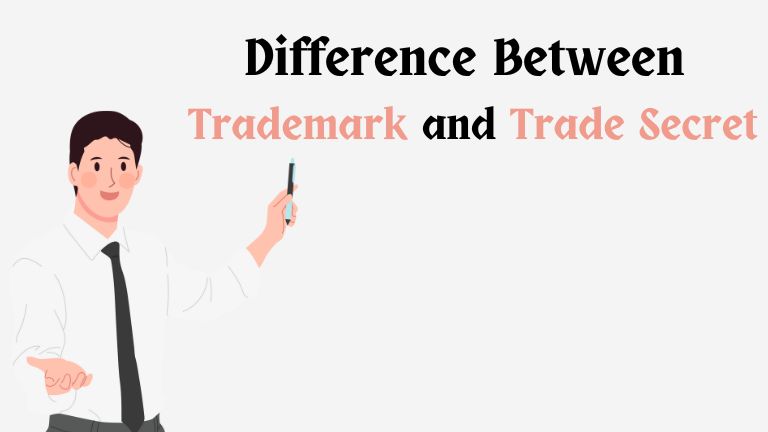In the world of intellectual property (IP), businesses have
numerous tools to protect their innovations, branding, and proprietary
information. Among the various forms of IP protection are trademarks and trade
secrets. While both serve to protect valuable business assets, they function in
fundamentally different ways and offer distinct forms of legal safeguards.
In this article, we’ll explore the Difference between Trademark and Trade Secret, their legal significance, and how businesses can
effectively utilize these tools to safeguard their interests.
What is a
Trademark?
A trademark is a recognizable sign, symbol, name, logo, or
any other distinctive element that identifies and differentiates the products
or services of one company from those of others. Trademarks serve as the face
of a brand, building consumer trust and ensuring that customers can easily
identify the source of goods or services.
Key
Features of Trademarks:
1. Recognition
and Brand Identity: Trademarks help create brand identity and reputation
in the marketplace. For instance, when consumers see the Nike “swoosh” logo,
they immediately associate it with Nike’s products.
2. Legal
Protection: Once registered, a trademark gives its owner the exclusive
right to use that mark in connection with specific goods or services. This
means that others cannot legally use the same or similar marks in a way that
might cause confusion among consumers.
3. Public
Record: Trademarks are publicly registered with a government body, such
as the U.S. Patent and Trademark Office (USPTO), and provide notice to everyone
that the trademark belongs to a specific entity.
4. Duration: Trademarks
can potentially last forever, provided they are properly renewed and
continuously used in commerce. For example, many of the world’s largest brands
have held their trademarks for decades.
How to
Protect a Trademark:
To protect a trademark, businesses must go through a
registration process with the appropriate trademark office in the country or
region where they seek protection. Trademark protection is territorial, meaning
that a U.S.-registered trademark is not necessarily protected in Europe unless
it is separately registered there.
Once registered, the owner of the trademark has the right to
sue infringers and can prevent competitors from using confusingly similar
marks. Trademark law protects the consumer as well as the trademark owner by
ensuring that consumers are not misled about the source of products or
services.
What is a
Trade Secret?
A trade secret, on the other hand, refers to any confidential
business information that provides a competitive edge. This could be formulas,
practices, processes, designs, instruments, or compilations of information that
are not known to the public and that a business takes reasonable steps to keep
confidential.
Unlike trademarks, trade secrets are not registered with any
government office. Their protection hinges on maintaining secrecy, and if the
information becomes public, its legal protection is generally lost.
Key
Features of Trade Secrets:
1. Confidential
Information: Trade secrets can include manufacturing processes, customer
lists, marketing strategies, and even software algorithms. A famous example is
the Coca-Cola recipe, which has been kept a closely guarded secret for over a
century.
2. No
Registration Required: Unlike trademarks, trade secrets do not require any
formal registration. They are protected as long as they remain secret and are
only disclosed to individuals under confidentiality agreements or other secure
conditions.
3. Duration: Trade
secrets can theoretically last indefinitely, but only if the secrecy is
maintained. If a trade secret is leaked or independently discovered by a
competitor, the protection is lost.
4. Legal
Action: If a trade secret is misappropriated or stolen, businesses
can seek legal action under trade secret law, such as the Defend Trade Secrets
Act (DTSA) in the U.S.
How to
Protect a Trade Secret:
Protection of trade secrets hinges on maintaining their
confidentiality. Companies typically use non-disclosure agreements (NDAs),
restrict access to sensitive information, and implement stringent internal
policies to safeguard trade secrets. A key element of trade secret law is that
the business must take reasonable measures to ensure the confidentiality of the
information.
If a trade secret is leaked or stolen, the business can file
a lawsuit to prevent the further spread of the secret and to recover damages.
However, once the secret is out, it loses its protected status, so proactive protection
measures are critical.
Major Difference between Trademark and Trade Secret
1. Nature
of Protection:
Trademark: Protects
brand identity and serves as a source identifier for products or services.
Trade
Secret: Protects confidential business information that gives a
company a competitive advantage.
2. Visibility:
Trademark: Publicly
registered and visible to consumers. The primary goal is to increase visibility
and recognition in the marketplace.
Trade
Secret: Must be kept confidential and protected from public
knowledge. The goal is to prevent others from learning or using the secret
information.
3. Registration:
Trademark: Requires
formal registration with a government body to secure legal protection.
Trade
Secret: No formal registration process is required; protection is
based on maintaining secrecy.
4. Duration:
Trademark: Can last
indefinitely as long as it is renewed and used in commerce.
Trade Secret: Lasts as
long as the information remains secret. If the secret is revealed or
independently discovered, the protection is lost.
5. Legal
Recourse:
Trademark:
Infringement occurs when another party uses a mark that is confusingly similar to
a registered trademark. The trademark owner can sue to prevent use and claim
damages.
Trade
Secret: Legal recourse is available if a trade secret is
misappropriated, but the business must prove that the information was a
protected secret and that reasonable steps were taken to maintain its
confidentiality.
6. Cost:
Trademark: Involves
registration fees and potential legal costs for monitoring and enforcing the
trademark.
Trade
Secret: No registration fees, but businesses may incur costs in
protecting the secret (e.g., security measures, NDAs, legal contracts).
When to Use
Trademarks and Trade Secrets?
Businesses often use both trademarks and trade secrets in tandem,
as they serve different purposes. A company might register a trademark registration for its
brand name and logo, while simultaneously maintaining certain operational
processes or product formulations as trade secrets.
For example, a restaurant might trademark its logo and menu
design while keeping its signature sauce recipe a trade secret. In the tech
world, companies like Google trademark their name and logo but keep their
search algorithms under lock and key as trade secrets.
Choosing whether to protect information as a trademark or a
trade secret depends on the nature of the asset and how it is used. If the goal
is to publicly distinguish a product or service, a trademark is the better
option. If the goal is to maintain competitive advantage through confidentiality,
trade secret protection is more appropriate.
Conclusion
While both trademarks and trade secrets provide vital
protections for businesses, they operate in different spheres. Trademarks are
essential for protecting a company’s brand identity and public recognition,
while trade secrets safeguard confidential business information that provides a
competitive edge. Understanding the difference between the two and leveraging
them effectively can help businesses enhance their intellectual property strategy
and safeguard their most valuable assets.

